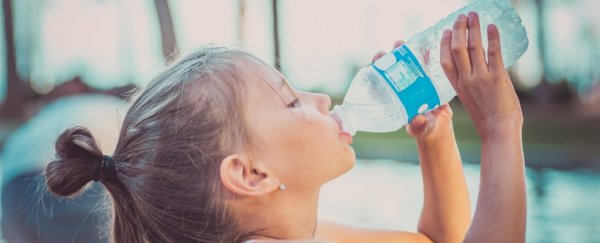Humans have spread microplastics to virtually every ecosystem on the planet, from the deepest chasms in the sea to the most remote wilderness on land. Today, there is nowhere left to hide, and each year, we humans receive a hearty dose of our own medicine.
From what little we know about microplastics in air, food and water, Canadian researchers have now estimated that the average person consumes more than 74,000 particles of plastic each year.
In all likelihood, the authors admit, this undervalues the reality. Due to a lack of data, the research was limited to only a few categories, including fish, shellfish, added sugars, salts, alcohol, tap or bottled water, and - of course - the air we breathe.
Based on a thorough review of the literature, including 26 peer-reviewed studies, the team created a microplastics database which they then compared to US dietary data. Depending on a person's age and sex, the number of particles consumed yearly sat somewhere between 74,000 and 121,000 particles.
Of all the items in the database, air, bottled water, and seafood accounted for most of the microplastic intake, although these also had the most variation depending on your location and food intake.
"This report provides an alarming indication of the wider impacts of plastic pollution," says Thavamani Palanisami, a researcher in contamination risk assessment at the University of Newcastle who was not involved in this research.
"It's a crisis that is not only blighting our landscapes and oceans but affecting the food we eat and the water we drink."
While the results might sound scary at first, the authors themselves admit that there's a lot of variation in the underlying data. They also remind readers that their estimates are based solely on the average American's daily food consumption, and only 14 percent of the caloric intake at that.
"Extrapolating the number of microplastics consumed with the remaining 85 percent of calories is not possible," the authors write, "however, if our findings are remotely representative, annual microplastic consumption could exceed several hundred thousand."
Without including cultural differences in diet, or staples like meat, dairy, grains, and vegetables (data which does not yet exist), these results are more of a ballpark figure. What's more, the research says nothing about the costs, if any, to human health.
Today, the effects of consuming microplastics are largely unknown, and yet there's little doubt that it's going on right now at unprecedented volumes. A study at the end of last year made headlines when researchers found evidence of microplastics in human fecal samples from all over the world.
The potential pathways for harm are many, and scientists have only proposed a few. Once microplastics enter the gut, they could release toxic substances causing oxidative stress or even cancer, according to the researchers. Particles small enough could be taken up by cells in the lungs and gut; while larger ones might be absorbed in the digestive tract. What happens from here is anyone's guess.
"The key and serious question before us is: what is the impact of microplastics once they are inside the human body?" says Anas Ghadouani, an environmental engineer at the University of Western Australia, who was not involved in the research.
"We know that humans can ingest or inhale microplastics, there is no doubt anymore about this one. The key question, is what happens next? What are the physical impact of particles travelling inside the bloodstream? Where is the next stop? Human brain? Many questions for the scientist to try to answer in a short period of time because this is urgent."
If the goal in the meantime is to avoid microplastic ingestion, the authors suggest quitting bottled water first. In their findings, microplastic consumption in water changed considerably depending on whether it came from a bottle or the tap.
Compared to water from a pipe, for instance, the authors found bottled water contained 90 more microplastic particles per litre. Practically this means for male adults, drinking only bottled water led to a daily microplastic intake of 349 particles. On the other hand, drinking only tap water led to a daily intake of 16 particles.
Still, in all likelihood, avoiding bottled water is just a drop in the bucket. While more direct research needs to be done, the trend so far suggests that microplastics will continue to be found in many, if not all, items intended for human consumption.
"If the precautionary principle were to be followed, the most effective way to reduce human consumption of microplastics will likely be to reduce the production and use of plastics," the authors conclude.
The research was published in Environmental Science and Technology.
